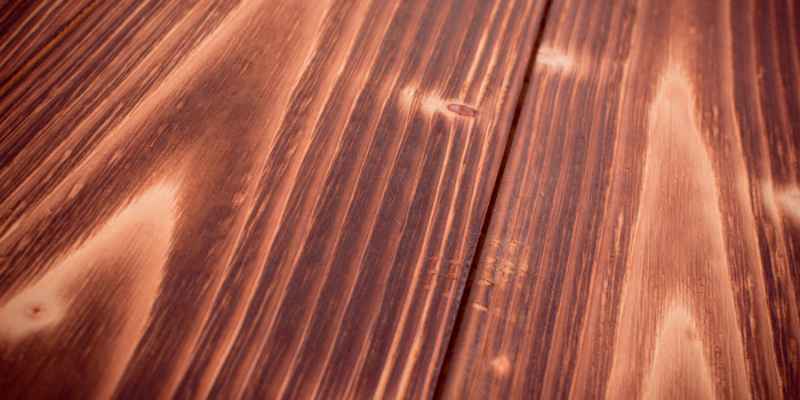To darken cherry wood, use water-soluble dye or apply double boiled linseed oil and wood dye. This will achieve desired results quickly and effectively, matching the existing cherry wood color.
Aging cherry wood can also be enhanced by wiping it with a lye solution or exposing it to UV light for a reddish-brown tint. Various techniques like diluting baking soda in water or using specific stains can help achieve the desired darkening effect for cherry wood projects.
Remember that cherry wood naturally darkens over time, but these methods can accelerate the process and provide consistent, uniform results.
Understanding The Cherry Wood
Characteristics Of Cherry Wood
Cherry wood is known for its rich, reddish-brown hue and fine grain.
- Color: Reddish-brown
- Grain: Fine
- Texture: Smooth
Natural Aging Process Of Cherry Wood
Cherry wood naturally darkens over time due to exposure to UV light, developing a deeper reddish-brown color.
- Age: Develops richness over time
- Exposure: UV light enhances color
Techniques For Darkening Cherry Wood
Learn How to Darken Cherry Wood using effective techniques. Discover the secrets to achieving a rich, dark color for your cherry wood projects, including using dyes, stains, and natural aging methods. Transform your cherry wood into a beautiful, uniform finish that will enhance the overall look of your woodworking projects.
If you have cherry wood furniture or flooring that you want to darken, there are several techniques you can try. From chemical staining methods to natural darkening processes, you have options to achieve your desired result. In this section, we will explore these techniques in detail.
Chemical Staining Methods
Chemical staining methods are an effective way to darken cherry wood. They involve the use of dyes or chemicals that react with the wood to create a darker color. Here are a few popular chemical staining methods for darkening cherry wood:
- Double-Boiled Linseed Oil: Using double-boiled linseed oil in combination with a light solution of trade-sale ready wood dye can help achieve a darker hue for cherry wood. This method is recommended for aging cherry wood.
- Baking Soda Solution: Diluting baking soda in water and applying it to the cherry wood can create a chemical reaction, resulting in a darker color. This technique is easy to do at home and can produce satisfying results.
- Water-Soluble Dye: Using a water-soluble dye, such as the woodworker’s supply antique cherry dye, can bring out the natural beauty of cherry wood while darkening its color. This method is simple yet effective.
Natural Darkening Processes
If you prefer a more natural approach to darkening cherry wood, there are a few processes you can try:
- Exposure to UV Light: Over time, cherry wood will naturally darken when exposed to UV light. To expedite the process, consider placing the cherry wood furniture or flooring in direct sunlight or using UV lamps.
- Lye Treatment: Treating cherry wood with a solution of lye can accelerate the natural aging process, resulting in a lovely reddish-brown color. This technique is often used by woodworkers to achieve an antique look.
In conclusion, when it comes to darkening cherry wood, you have various techniques at your disposal. Whether you choose chemical staining methods or natural darkening processes, it’s important to consider factors such as desired color, safety precautions, and personal preference. Experiment with different techniques to achieve the desired result and enjoy a beautifully darkened cherry wood finish.
Using Stains And Dyes
To darken cherry wood, consider using stains or dyes like Sherwin-Williams for a rich, uniform color. Additionally, aging cherry wood naturally with UV light or starting the process with lye can achieve a lovely reddish-brown hue. Experiment with different methods to find the perfect shade for your project.
Application Of Water Soluble Dyes
To effectively darken cherry wood, one popular method is using water soluble dyes. These dyes are specially formulated to penetrate the wood fibers, creating a long-lasting and rich color.
Here’s a step-by-step guide on how to apply water soluble dyes to achieve the desired darkness:
- Start by preparing the cherry wood surface. Ensure it is clean, dry, and free from any dust or debris.
- Mix the water soluble dye according to the manufacturer’s instructions. It’s recommended to wear gloves and work in a well-ventilated area.
- Using a brush or a cloth, apply a thin and even coat of the dye onto the wood surface. Work in the direction of the wood grain to ensure proper absorption.
- Allow the dye to penetrate the wood for the recommended amount of time. This can vary depending on the manufacturer’s instructions and the desired darkness level.
- After the suggested time has passed, remove any excess dye by wiping the surface with a clean cloth.
- Let the wood dry completely before applying any protective finish.
- Repeat the dyeing process if a darker shade is desired, taking caution not to over-saturate the wood.
Keep in mind that the final color achieved will depend on factors such as the type of dye used, the number of coats applied, and the natural color and grain pattern of the cherry wood.
Effects Of Different Stains
In addition to water soluble dyes, stains can also be used to darken cherry wood. Stains are available in various colors and can create unique effects depending on the type and tone chosen.
Here are some popular stain options to consider:
| Stain Type | Effect on Cherry Wood |
|---|---|
| Dark Walnut | Creates a deep, rich brown tone, enhancing the natural beauty of the cherry wood. |
| Ebony | Gives a dramatic and bold black color, offering a distinct contrast against the cherry wood. |
| Red Mahogany | Produces a reddish-brown hue, adding warmth and depth to the cherry wood. |
| Antique Cherry | Offers an aged and rustic appearance, mimicking the natural darkening process of cherry wood over time. |
Before applying any stain, it’s essential to test it on a small, inconspicuous area of the cherry wood to ensure the desired color is achieved. Remember to follow the manufacturer’s instructions for proper application and drying times.
Darkening cherry wood using stains can be a rewarding process, allowing you to customize the appearance of your furniture or woodworking projects to suit your preferences. Experiment with different stains and techniques to discover the perfect shade that brings out the natural beauty of cherry wood.
Natural Darkening Methods
Placing cherry wood in direct sunlight helps accelerate the natural darkening process.
Utilizing age-accelerating techniques like applying lye solution can speed up the darkening of cherry wood.
Exposure to Sunlight: Placing cherry wood in direct sunlight helps accelerate the natural darkening process.
Age-Accelerating Techniques: Utilizing age-accelerating techniques like applying lye solution can speed up the darkening of cherry wood.
Preventing Uneven Darkening
To prevent uneven darkening when darkening cherry wood, ensure that the wood is evenly sanded and cleaned before applying the stain or dye. Apply the stain in thin, even coats, allowing sufficient drying time between applications. Additionally, consider using a pre-stain wood conditioner to ensure an even finish.
Challenges With Cherry Wood
Cherry wood can darken unevenly due to its natural properties and variation in grain density.
Tips To Ensure Uniform Darkening
Preventing uneven darkening on cherry wood requires thorough preparation and careful application.
- Avoid mineral stains by sanding with a fine-grit sandpaper.
- Use a pre-stain conditioner to promote even absorption of the darkening agent.
- Apply the darkening agent evenly with a clean cloth or brush in long, smooth strokes.
- Allow the wood to dry completely before applying a protective finish.
| Challenges | Tips |
|---|---|
| Natural properties | Avoid mineral stains by sanding |
| Grain density variation | Use pre-stain conditioner for even absorption |
Following these tips will help you achieve a uniform darkening on your cherry wood project.
Best Practices For Darkening Cherry Wood Furniture And Cabinets

Darkening cherry wood furniture and cabinets can give them a rich and luxurious look. Whether you want to match existing furniture or simply enhance the beauty of your cherry wood surfaces, there are various techniques and strategies you can employ. In this article, we will explore the best practices for darkening cherry wood furniture and cabinets, focusing on techniques for furniture and strategies for cabinets.
Techniques For Furniture
When it comes to darkening cherry wood furniture, there are a few techniques you can try. Here are some of the most effective ones:
- Apply a dark wood stain: Choose a high-quality wood stain in a dark shade that complements the natural color of cherry wood. Apply the stain evenly with a brush or a cloth, following the manufacturer’s instructions.
- Use a dye: Dyes can penetrate deeper into the wood and provide a more uniform color. Consider using a water-soluble dye that is specifically formulated for cherry wood.
- Age the wood with lye: To achieve an aged look, you can wipe down the wood with a solution of lye. This will speed up the natural aging process and darken the cherry wood.
- Utilize a chemical reaction with baking soda: Dilute baking soda in water and apply it to the cherry wood. This will create a chemical reaction that darkens the wood.
Strategies For Cabinets
Darkening cherry wood cabinets requires a slightly different approach. Here are some strategies you can use:
- Remove the cabinet doors and hardware: Before applying any darkening technique, make sure to remove the cabinet doors and hardware to ensure an even application.
- Apply a dark stain or dye: Just like with furniture, you can use a dark wood stain or dye to darken the cabinets. Make sure to apply the stain or dye evenly and follow the instructions provided.
- Sand the cabinets: If your cabinets have a clear finish, you may need to sand them lightly to remove the existing finish and create a more porous surface for the stain or dye to adhere to.
- Finish with a protective sealant: Once you have achieved your desired level of darkness, finish the cabinets with a protective sealant to preserve the color and provide durability.
Remember to always test your chosen technique or strategy on a small, inconspicuous area of the furniture or cabinets before applying it to the entire surface. This will allow you to see how the cherry wood reacts to the darkening process and make any necessary adjustments. With the right approach and careful application, you can successfully darken cherry wood furniture and cabinets to achieve the desired look for your space.
Frequently Asked Questions On How To Darken Cherry Wood
Can Cherry Wood Be Stained Dark?
Yes, cherry wood can be stained dark to achieve a rich, dark reddish-brown color. You can use dye or chemical stain to create a uniform dark stain for cherry wood. Additionally, you can speed up the aging process by wiping the wood with a lye solution.
Can You Change The Colour Of Cherry Wood?
Yes, you can change the color of cherry wood by using dyes, stains, or lye treatments.
How Do You Age Cherry Wood?
To age cherry wood, you can expose it to UV light and over time it will naturally darken to a reddish-brown color. Alternatively, you can wipe down the wood with a solution of lye to speed up the aging process.
Another method is to use a water soluble dye or double boiled linseed oil.
What Is A Good Stain For Cherry Wood?
A good stain for cherry wood is Burnished Michaels Cherry or Sandstone in Cherry. These stains can give cherry wood a rich and dark reddish-brown color.
Conclusion
Darkening cherry wood can be achieved with various methods like dyes or chemical staining. Natural aging and exposure to UV light can also enhance cherry’s color. Experiment with different techniques to find what works best for your desired finish. Happy woodworking!


